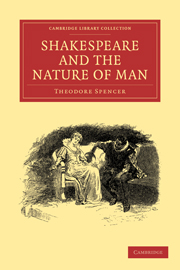Book contents
- Frontmatter
- Preface
- Contents
- SHAKESPEARE and THE NATURE OF MAN
- I Man in Nature: the Optimistic Theory
- II Man in Nature: the Renaissance Conflict
- III The Dramatic Convention and Shakespeare's Early Use of It
- IV Hamlet and Troilus and Cressida
- V Othello and King Lear
- VI Macbeth and Antony and Cleopatra
- VII Shakespeare's Last Plays
- VIII Literature and the Nature of Man
- Index
VII - Shakespeare's Last Plays
Published online by Cambridge University Press: 07 September 2010
- Frontmatter
- Preface
- Contents
- SHAKESPEARE and THE NATURE OF MAN
- I Man in Nature: the Optimistic Theory
- II Man in Nature: the Renaissance Conflict
- III The Dramatic Convention and Shakespeare's Early Use of It
- IV Hamlet and Troilus and Cressida
- V Othello and King Lear
- VI Macbeth and Antony and Cleopatra
- VII Shakespeare's Last Plays
- VIII Literature and the Nature of Man
- Index
Summary
The play that Shakespeare wrote after Antony and Cleopatra is his last serious presentation of man in relation to the state. Macbeth is one kind of political play, in that it describes how a country suffers as its king grows evil; Antony and Cleopatra is another kind, in that it describes the conflict between passion and empire; Coriolanus is a third kind, in that it portrays the conflict between the two halves of a commonwealth: the leader who is too proud, and the people who are too foolish, to arrive at any orderly collaboration.
Coriolanus is an excellent piece of dramatic craftsmanship; the action is varied and exciting, the main characters are strongly drawn, the climax is made to seem inevitable, and unlike Troilus and Cressida, for example, the play is a single firm unity. But it has never been popular, and though we admire it, we admire it in cold blood. We feel that it is a study in human behavior, as Ben Jonson's plays are studies, and this is a feeling we never have when we think of Hamlet or of Lear. Coriolanus is the product of a remarkably vigorous and able mind, who sees what the dramatic problem is and solves it with remarkable distinction and success. But it is a tight play; it does not open vistas, like Antony and Cleopatra; it closes them.
- Type
- Chapter
- Information
- Shakespeare and the Nature of Man , pp. 177 - 202Publisher: Cambridge University PressPrint publication year: 2009First published in: 1943

